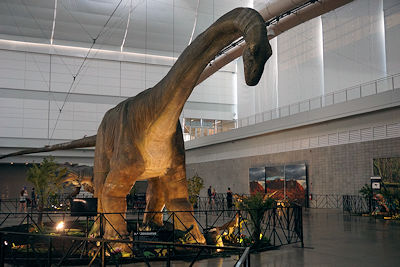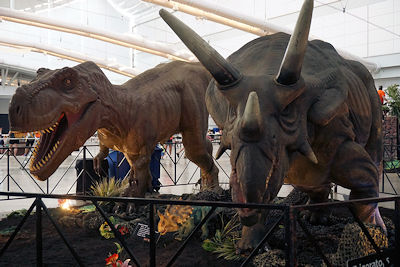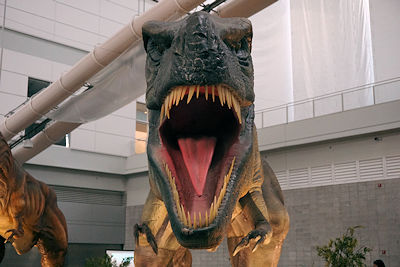
Alan Grant was a world-renowned paleontologist when he was invited in 1993 by John Hammond to the island of Isla Nublar. Despite the numerous dig sites that he had been part of during his career, the untold number of fossils he uncovered, a lifetime of research and an ongoing quest to learn more – nothing had prepared Grant for that moment when he spotted a living, breathing dinosaur for the first time in Jurassic Park.
It turns out that everyone loves dinosaurs, not just paleontologists. Decades after the release of the first Jurassic Park film, children and adults alike are filled with that same sense of awe when gazing at the fossilized remains of a Brachiosaurus or Tyrannosaurus Rex on display in museums across the country. For those looking to more fully duplicate the experience of Alan Grant, however, Jurassic Quest – a traveling entertainment exhibit featuring life-size animatronic dinosaurs – might be the ticket.
Human fascination with dinosaurs has existed for close to two centuries. Mary Anning walked the beach of Lyme Regis, England, every day for thirty-five years in the early 1800s, obsessed with the fossilized remains of “lizard fish” that she had previously found there. Then in 1854, the Crystal Palace in London’s Hyde Park unveiled over a dozen life-sized dinosaur sculptures that may not be scientifically accurate by today’s standards but continue to captivate visitors nonetheless.
The discovery of dinosaur fossils in the United States kicked off a “Bone War” in 1877 between paleontologists Edward Drinker Cope and Othniel Charles Marsh, with each trying to outdo the other – often in the most duplicitous of ways – when it came to finding new species. Despite the treachery, their achievements increased the nation’s growing fascination with dinosaurs just the same, resulting in museums across the country hunting for their own fossilized remains.
That fascination with dinosaurs extends to fictional narratives as well. Sir Author Conan Doyle, for instance, penned The Lost World in 1912, a novel that imagined an isolated plateau in South America that still contained prehistoric creatures from the past. King Kong, meanwhile, battled a dinosaur on Skull Island in 1933, while moviegoers were transported back in time to One Million B.C. the following decade.
The on-going quest to immerse ourselves in the lost world of dinosaurs hit a peak in 1993 with the release of Jurassic Park, directed by Steven Spielberg and based on the novel by Michael Crichton. Thanks to advancements in CGI technology, dinosaur enthusiasts were able to witness a modern-day park filled with the creatures – as well as the dangers of resurrecting species that had been extinct for sixty-five million years.
Despite over a hundred years of fascination, the thirst for all things dinosaur has yet to be quenched. A new twist has been added in recent years with the advent of animatronic dinosaurs. These life-size replicas contain mechanical gears inside that allows them to move and mimic the motions of actual dinosaurs, creating the closest facsimile to a genuine “Jurassic Park” to date.
While a handful of museums worldwide use a small number of animatronic dinosaurs to complement their traditional fossilized displays, the mechanical creations are primarily used for entertainment purposes. Over a half-dozen Dinosaurs Alive! parks had popped up within the United States by 2013, but those permanent attractions have since given way to traveling exhibits, with the highly successful Jurassic Quest being the most prominent.
Taking up large chunks of convention center space, Jurassic Quest not only contains mid-size dinosaurs like Triceratops and Stegosaurus but such behemoths as the gigantic Apatosaurus and towering Tyrannosaurus Rex as well. Making one’s way through the maze of dinosaurs is safer than the tour taken by Allen Grant, Ellie Sattler, and Ian Malcolm on Isla Nublar, while watching an animatronic T-Rex open-and-close its massive jaw can be every bit as frightening.
Although primarily geared towards children, Jurassic Quest attracts a diverse segment of the population – from college-aged couples to those in retirement, single men and woman of all ages, African Americans and Asian American, and everyone else in-between. In an age that contains so many divisions within society, dinosaurs appear to transcend and unite rather than divide.
Jurassic Quest may emphasize entertainment but that does not mean it forsakes the educational. Graphics on various species and time periods are sprinkled throughout, and while there are dinosaur rides and play areas for younger kids, assorted fossil digs and science experiments are available for those older as well.
Despite its impressive use of animatronics, Jurassic Quest may not by the most authentic way to explore the world of dinosaurs – that is left to museums like the American Museum in New York, the Carnegie Museum in Pittsburgh, and the Field Museum in Chicago – but it does illicit a thrill nonetheless and gives one the sense of what it would be like if dinosaurs walked amongst us.
“Dinosaurs and man, two species separated by sixty-five million years of evolution, have just been suddenly thrown back into the mix together,” Alan Grant observed in the original Jurassic Park. The statement may not be literally true, but Jurassic Quest does its best to replicate the feeling felt by Grant on Isla Nublar while continuing a quest into the past that began centuries ago.
Anthony Letizia





